The management of dust in transfer stations and material recovery facilities (MRFs) is crucial due to health, regulatory, and safety concerns. Fugitive dust can lead to fines, citations, and even fires if uncontrolled. In addition to these issues, insurance companies are becoming increasingly aware of the fire hazards of combustible dust, adding to the liability associated with poor dust management.
One of the primary dangers of fugitive dust is its potential to fuel fires. An overly dusty MRF is a fire hazard, especially when combined with other potential ignition sources, such as damaged lithium-ion batteries. Excessive dust provides additional fuel for fires, making controlling dust in waste and recycling facilities an essential part of your environmental health and safety efforts.
Not All Dust is Created Equal
Due to the variety of dust in facilities like waste and recycling centers, you must also be prepared for combustible dust. The risk for this dust type is more than just fuel; it is, in and of itself, a combustion source.
Dust control is not only about compliance but also about protecting employees’ health. Workers in transfer stations and MRFs can inhale suspended dust particles as materials are moved and processed, posing health risks. The people you rely on to run your facility, rely on you to maintain a safe environment for them to work, including being safe from a combustible dust event.
Dangers of Dust
(Excerpt from “Clearing the Air,” by Bob Gaetjens, Waste Today, Jul-Aug 2023)
If left uncontrolled, dust can result in fines and citations from OSHA, but Jordan Newton, P.E., Chief Operating Officer at SonicAire says the real danger is to employees’ health and the overall facility.
He says one primary danger associated with dust is the risk of fires and explosions. If too much dust accumulates on surfaces within a facility or is suspended in the air, it can fuel either one, depending on the environment.
Newton says an overly dusty MRF lacks only an ignition source for a fire. “You’ve got fuel from the dust; you’ve got suspension from the dust; you’ve got confinement, generally, if you’ve got four walls; and there’s oxygen in the air.”
Usually, he says, excessive dust provides additional fuel to a fire started from another source, which can sometimes be damaged lithium-ion batteries.
The associated liability increases as understanding of the dangers that combustible dust presents increases.”Insurance companies are becoming more and more aware of the fire hazards and risks around combustible dust,” Newton says.
Dust also can become a health hazard if it’s suspended in the air and inhaled by employees, which he says is possible in transfer stations and MRFs as material is moved and processed.
Several strategies and equipment can be used to control dust and odor in facilities, with two of the most popular approaches being misters and fans. SonicAire’s dust control fans are designed to prevent fugitive dust that has escaped other collection methods from settling in hard-to-reach areas within a facility, creating air barriers that force dust back to the ground, making it easier to collect.
These fans effectively manage all types of dust and do not face challenges like water or moisture-based systems, which can require continuous water supply and pose issues like equipment rusting.
Alternative solutions, such as vacuum systems, are cyclic in that vacuuming must be done over and over; start on one end of your facility and by the time you finish, it’s time to start back where you began. They also pose a serious risk if done DIY-style. You can ignite the dust in the vacuum with the wrong equipment and cause an explosion.
Manual cleaning, another popular option, can be costly, labor-intensive, and inconsistent due to workforce turnover. With labor shortages, facilities that rely on manual cleaning may need help finding and retaining employees to conduct these manual cleanings. You may have trouble finding a cleaning company that can fit you into their schedule when you need it due to their difficulties finding and retaining staff.
The manual method may be short-sighted, as this solution requires consistent execution, whereas dust control fans require very little thought or maintenance after installation.
Once you have your SonicAire fans installed, Dust is Done.
Ultimately, the Waste Today article claimed that the choice of a dust control system depends on the facility’s design and priorities. However, systematic dust control is essential for employee happiness, safety, compliance, and overall facility cleanliness.
For more information, click below to read the full article.
The Real Cost of Manual Dust Cleaning
It isn’t until you sit down and start adding up all of the costs the problem becomes apparent.
SonicAire Fans – A Cost-Effective Alternative
We’re not going to lie to you. Installing a SonicAire Dust Control Fan System requires an investment. There are very few facilities that can get by with a couple of fans. But the long-term benefits speak for themselves.
SonicAire fans either run for specified periods during the day or all day, depending upon your operations and dust production level. However, they use two different tactics to prevent combustible dust buildup in overhead areas.
First, they clean off higher surfaces with continual airflow. This prevents buildup and eliminates the cleaning of these areas. Second, a properly engineered system creates an Air Barrier to prevent warm air currents from bringing dust up into overhead spaces.
Let’s look at how they impact the costs we’ve highlighted above.
Measuring the Difference
Each facility is different. In manufacturing and processing, operations produce varying levels and types of fugitive dust. But each facility is likely overspending on manual cleaning or simply not cleaning enough.
When you consider the labor, equipment, and lost productivity that goes into manual cleaning practices and then add in the insurance costs, potential fines, and employee dissatisfaction. Is manually cleaning your facility really saving you money?
We’re confident our combustible dust control systems will save your facility money even with the initial investment to purchase and install. But, if you’re not 100% sold, we get it. That’s why we offer free dust management plans with ROI Analysis. These engineered plans recommend the amount and placing of fans to ensure maximum protection from dust buildup.
Click here to request your Free Dust Management Plan.
Or contact us to discuss dust control solutions for your facility.
If you work in a facility that deals with combustible dust on a daily basis, you probably know the regulations and standards you’re required to comply with in order to maintain a safe facility. (Or, at the very least, to save yourself from OSHA fines.) The National Fire Prevention Association (NFPA) creates standards for nearly everything that presents a risk for fire or explosion.
And that includes combustible dust.
But when you compare the standards the NFPA has created for general combustible dust use against the standards they’ve created for industry-specific combustible dust, it can cause some confusion. If the fundamentals of combustible dust give one kind of guidance, but the directives on a specific type of dust (grain dust, for example) provide conflicting instruction, what should you do?
It’s worth noting that there are already several standards on combustible dust currently. They cover everything from the fundamentals to general guidance to an individual standard for each industry dealing with combustible dust. It adds up to a lot of standards that any person working with combustible dust must understand and comply with. It may not be impossible, but it certainly isn’t easy; a fact the NFPA understands and is attempting to improve.
The new NFPA standard 660 seeks to make these complications a thing of the past.
What is NFPA 660?
First and foremost, NFPA 660 consolidates standards on combustible dust. It will make it a “one-stop-shop” for combustible dust. It uses the information in NFPA standards 652, 61, 484, 654, 655, and 664 to create this new standard. So while most of the information will be “recycled” from the existing standards, some of it will be a closer look at the specifics for each commodity and industry.
So How Will the Standard Break Down?
- Chapters 1-9: Deals with fundamentals and replaces NFPA 652, Standard on the Fundamentals of Combustible Dust
- Chapter 10: Replaces NFPA 61, Standard for the Prevention of Fires and Dust Explosions in Agricultural and Food Processing Facilities, regarding Agriculture and Food
- Chapter 11: Replaces NFPA 484, Standard for Combustible Metals
- Chapter 12: Replaces NFPA 654, Standard for the Prevention of Fire and Dust Explosions from the Manufacturing, Processing, and Handling of Combustible Particulate Solids
- Chapter 13: Replaces NFPA 655, Standard for Prevention of Sulfur Fires and Explosions
- Chapter 14: Replaces NFPA 664, Standard for the Prevention of Fires and Explosions in Wood Processing and Woodworking Facilities
What happens to NFPA standards 652, 61, 484, 654, 655, and 664?
Mostly, the standards currently dealing with combustible dust will become obsolete after NFPA 660 is approved and published. The good news is that the new standard will simply reiterate a significant amount of the content within each standard, but the bad news is that, yes, your old “how-to” will no longer be your “go-to.”
Not all standards dealing with all combustion will be obsolete, though, nor will they be consolidated in 660. There was some debate on the inclusion of the general “how-to” standards, but it looks like the conclusion was to reference the standards but not consolidate them. That means that, for example, NFPA 68: Standard on Explosion Protection by Deflagration Venting and NFPA 69: Standard on Explosion Prevention Systems will not be included in the consolidation but will be referred to when applicable in NFPA 660.
What’s Likely to Change in NFPA 660?
When it comes to the fundamentals, not a lot has changed. In fact, if you’re already doing what you should be doing for combustible dust management, a lot will remain the same. You’ll still need to have a Dust Hazard Analysis (DHA) performed and maintained for your facility, and you’ll still need to control your combustible dust. The regulations about venting and dust storage and documentation requirements will all remain the same.
However, you should note that the industry-specific standards do have some changes, most notably the standards on metals. Due to the extreme range of hazards in the current standard NFPA 484 Standard for Combustible Metals (and future chapter 11 of NFPA 660), you should expect more of a deep dive into the safety and combustion prevention of this standard. It may keep your everyday procedures the same, or it may flip a few of your policies on their head.
In Jason Krbec’s presentation at the 2021 Global Dust Safety Conference, he addresses the most likely update we’ll see. “There will be expanded detail on housekeeping. You’re going to see a lot of improvement in that section.” Krbec says. “Housekeeping is usually the first line of defense against some of these combustible dust incidents, so it’s very important. This will definitely be in the code.”
Other updates you can expect circle back to the consolidation of all combustible dust standards. Because each standard had its own committee of experts to write and publish it, the fundamentals of combustible dust (NFPA 652) were open to interpretation.
According to a podcast with Laura Moreno, Standards Lead, Industrial and Chemical Engineering at NFPA, on Dust Safety Science, the different interpretations were causing inconsistent requirements. “The NFPA standards cover all industries and occupations associated with combustible dust, but they had some inconsistent requirements. There were also comments about how [this fact] could limit the effectiveness of their use, as well as how OSHA shouldn’t adopt NFPA standards because it’s hard to determine which requirements apply where.”
 What Happens in the Event of a Conflict?
What Happens in the Event of a Conflict?
The NFPA understands that each industry has its own specific needs regarding combustible dust. If the fundamental chapters present information that doesn’t align with the data or instruction in the industry-specific chapter, the industry-specific will effectively trump the fundamental instructions.
By establishing this from the onset, the NFPA hopes to de-conflict several of the unforeseen issues of the past.
How Will I Be Able to Get It?
The NFPA is a not-for-profit organization that the federal government doesn’t control. As such, once published, the standard, like all others, will be available for purchase. Funds generated by purchases are used to create standards that keep your facility safe and compliant.
Code or Standard?
Currently, the NFPA 660 will be a standard just like those it will consolidate. However, because the intent is to become a “super standard” that becomes the final word on combustible dust, the NFPA hopes this standard will also become a code. Their goal is to develop 660 similarly to the National Electrical Code (formerly NFPA standard 70).
While a standard is not a law, a code could be, and the hope is that if accepted nationally, 660 will be the universal and unquestioned standard for combustible dust. OSHA would likely inspect facilities using the regulations of 660, and the suggestions for safety would become mandated. The consistency of a legal requirement would keep facilities safer and leave less room for unsafe shortcuts.
What Can YOU Do?
With an estimated publication date of Fall 2024, the standard is currently up for public input and will be until January 5, 2023.
The standard is currently under the public comment portion of its publication, which means it’s open to anyone to make suggestions and comments. The NFPA will immediately disregard any comment that requests endorsing any product, so you can’t use this as an opportunity to push your product.
We believe that if the NFPA could recommend a product without showing favoritism or causing problems for other businesses, they’d mention us as the best bet for combustible dust management. Once it’s finalized, we expect most of the regulations for controlling and preventing dust build-up to be virtually irrelevant to a facility with SonicAire fans installed.
SonicAire will remain your best choice for maintaining a safe and compliant facility.
Remember that the best form of protection against combustible dust is the prevention of it. Luckily, SonicAire offers that option to you with our dust control fans. When evaluating your options for explosive dust mitigation, always reference the hierarchy of combustible dust control for your safest option to remain compliant. (See below)
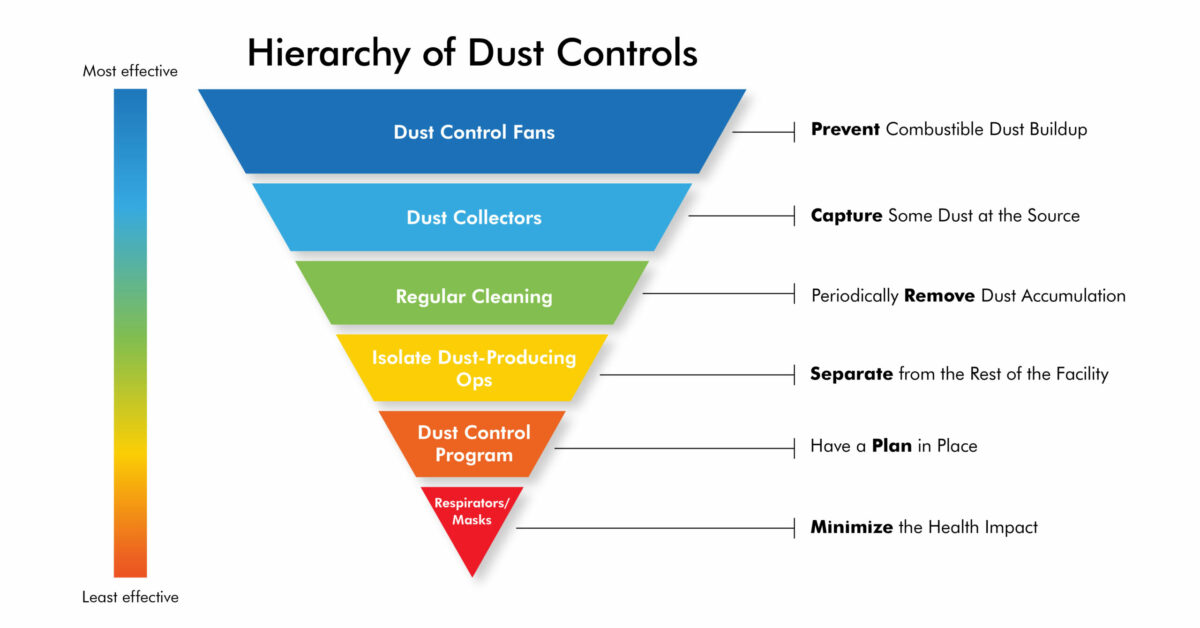
Public Workshop

This virtual workshop ran from Dec 5-9, 2022 but will be available for replay until January 5, 2023.
By registering, you’ll receive templates and examples for your response, as well as guides for navigating the NFPA website. You’ll even have the chance to submit a survey that the Dust Safety Academy will use to build lesson plans for the workshop.
Will This Affect Your SonicAire Fans?
Absolutely not. The standard will deal with the details of managing combustible dust and preventing dangers that its build-up can cause. With SonicAire fans, you won’t have to change how you handle your combustible dust. You’ll still be preventing it from ever becoming a problem, so those who already have SonicAire dust control fans installed in their facilities will be ahead of the curve for dust control.
The Real Cost of Manual Dust Cleaning
It isn’t until you sit down and start adding up all of the costs the problem becomes apparent.
SonicAire Fans – A Cost-Effective Alternative
We’re not going to lie to you. Installing a SonicAire Dust Control Fan System requires an investment. There are very few facilities that can get by with a couple of fans. But the long-term benefits speak for themselves.
SonicAire fans either run for specified periods during the day or all day, depending upon your operations and dust production level. However, they use two different tactics to prevent combustible dust buildup in overhead areas.
First, they clean off higher surfaces with continual airflow. This prevents buildup and eliminates the cleaning of these areas. Second, a properly engineered system creates an Air Barrier to prevent warm air currents from bringing dust up into overhead spaces.
Let’s look at how they impact the costs we’ve highlighted above.
Measuring the Difference
Each facility is different. In manufacturing and processing, operations produce varying levels and types of fugitive dust. But each facility is likely overspending on manual cleaning or simply not cleaning enough.
When you consider the labor, equipment, and lost productivity that goes into manual cleaning practices and then add in the insurance costs, potential fines, and employee dissatisfaction. Is manually cleaning your facility really saving you money?
We’re confident our combustible dust control systems will save your facility money even with the initial investment to purchase and install. But, if you’re not 100% sold, we get it. That’s why we offer free dust management plans with ROI Analysis. These engineered plans recommend the amount and placing of fans to ensure maximum protection from dust buildup.
Click here to request your Free Dust Management Plan.
Or contact us to discuss dust control solutions for your facility.
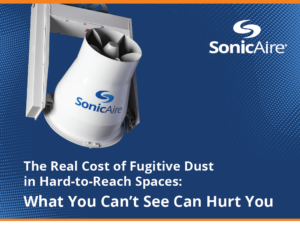
GET YOUR FREE GUIDE:
The Real Cost of Fugitive Dust in Hard-to-Reach Spaces
What You Can’t See Can Hurt You
To help protect your workplace, we’ve compiled the following resource, The Real Cost of Fugitive Dust in Hard-to-Reach Spaces: What You Can’t See Can Hurt You. In it, we identify seven ways fugitive dust is likely impacting your facility and its profitability.
These costs go beyond housekeeping and explain why you should be preventing dust buildup to protect the bottom line, not just to stay in compliance.

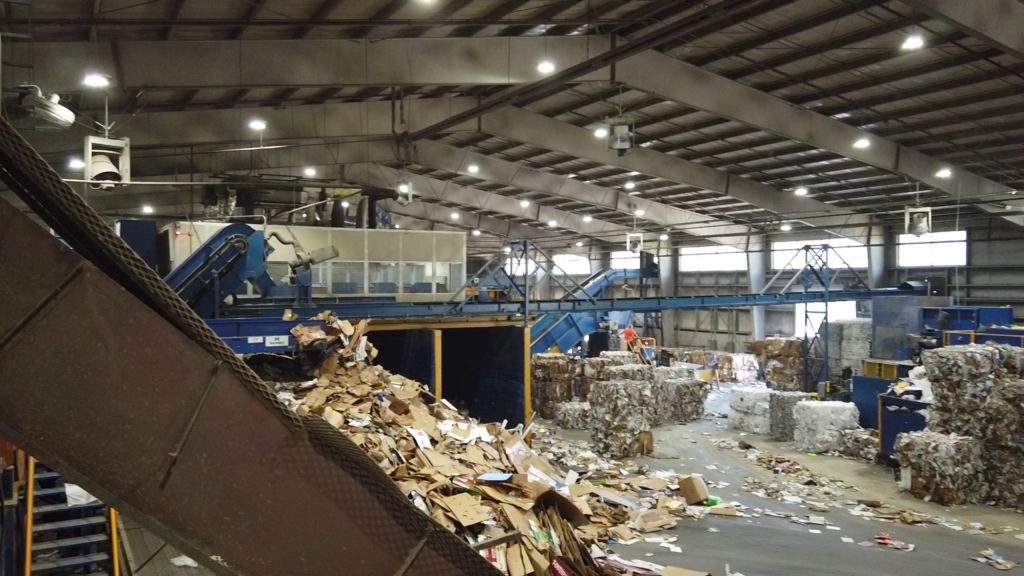
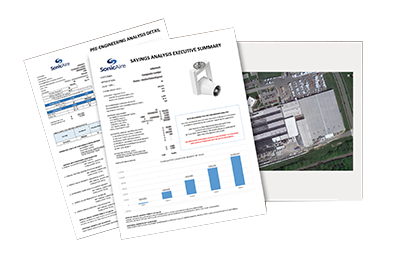
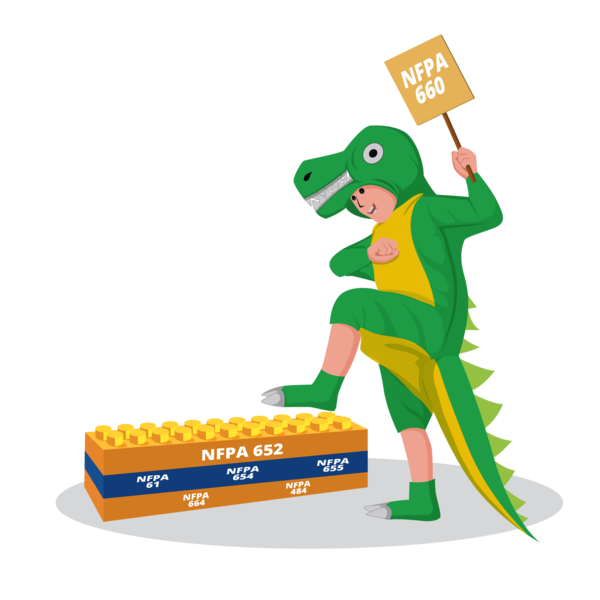
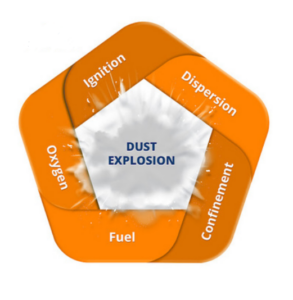 What Happens in the Event of a Conflict?
What Happens in the Event of a Conflict?